UnitAfieldtripAReadandwrite教学设计及练习题
UnitA.field trip A Lets talk教学设计及练习题

●活动设计②a.演一演:
教学参考时间:2-3分钟
学生打开书,试着自己朗读Let’s talk部分对话。
教师播放录音,学生跟读。
教师请一名学生上来背对大家,再请两名学生上来向台下的学生展示一个单词短语,然后一起做卡片上的动作,如:catching butterflies,台下的学生一起问:What are they doing?站在前面的学生用Are they…?句型来猜卡片上的短语。
【设计意图】通过游戏的方式引导学生进一步复习前面学过的句型和单词短语。
教学环节
师生活动
P
r
e
s
e
n
t
a
t
i
o
n
新
知
呈
现
’s start:
教师展示Let’s start部分的挂图。
教师问:What is Zhang Peng doing?引导学生回答:He is watching a fish.教师说:So, he belongs to Group A.
学生理解游戏规则后,再请两名学生作一个动作,请学生试着来猜:Are they…?其他学生判断:Yes,they are./ No, they aren’t.
教师在黑板上画一棵树,问:What is it?引导学生回答:It is a tree.
然后,教师再画一些树并介绍说:What is it now? It is a woods.教师板书woods,学生跟读单词。
Are they catching butterflies?
Are they picking up leaves?
What are his classmates doing?
2024年《A Field Trip》教案范文模板

一、教案基本信息1. 课程名称:英语阅读与写作2. 课时安排:45分钟3. 年级水平:八年级4. 教学目标:a. 学生能够理解并运用文章中的关键词汇和短语。
b. 学生能够掌握一般过去时的用法。
c. 学生能够通过阅读理解文章的主要内容和细节。
d. 学生能够运用文章中的信息进行简单的交流和写作。
二、教学内容1. 教学文本:《A Field Trip》2. 教学重点:a. 关键词汇和短语的学习和运用。
b. 一般过去时的用法。
c. 阅读理解能力的培养。
d. 运用文章中的信息进行交流和写作。
三、教学步骤1. 导入:a. 引导学生回顾之前学过的一般过去时的用法。
b. 引入本课的主题,即一次实地考察活动。
2. 阅读理解:a. 让学生阅读文章《A Field Trip》。
b. 学生在阅读过程中,记录下关键词汇和短语。
c. 学生回答关于文章主要内容和细节的问题。
3. 词汇学习:a. 教师引导学生学习和复习文章中的关键词汇和短语。
b. 学生通过例句和练习来巩固词汇的学习。
四、作业布置1. 让学生根据文章内容,写一篇关于他们自己的实地考察活动的短文。
2. 让学生找出文章中的错误,并进行改正。
五、教学反思1. 教师在课后对自己的教学进行反思,看是否达到了教学目标。
2. 教师要根据学生的反馈,调整教学方法和策略,以提高教学效果。
六、课堂活动1. 小组讨论:a. 学生分成小组,讨论他们在实地考察活动中的经历。
b. 每个小组选择一个代表,向全班分享他们的讨论成果。
2. 角色扮演:a. 学生分成小组,每组选择一个角色,如导游、学生等。
b. 每组进行角色扮演,模拟实地考察活动的场景。
七、语法练习1. 现在式与过去式的对比:a. 学生完成一系列的语法练习,比较现在式和过去式的用法。
b. 教师引导学生理解两种时态的区别和适用场合。
八、小组合作写作1. 小组讨论:a. 学生分成小组,讨论他们认为的实地考察活动的重要性和意义。
b. 每个小组选择一个代表,向全班分享他们的讨论成果。
UnifieldtripALetslearn教学设计及练习题

Unit6Afield trip
Part(A)Let’s learn
教
学
目
标
与
要
求
1.动词短语的ing形式:taking pictures,watching insects,picking up leaves,doing an experiment,catching butterflies。.
学生根据卡片提供的内容练习说唱儿歌。教师适当强调歌词中的发音和节奏处理。
学生以小组为单位练习儿歌,并为歌谣添加动作。
小组展示,同学之间给予适当评价。
●活动设计 ::Words-spelling
教师出示单词短语卡片:taking pictures,watching insects, picking up leaves, doing an experiment,catching butterflies学生拼读。
教师播放Let’s chant部分录音2-3遍,学生以小组为单位将单词短语的卡片按歌词中的顺序摆好。
应准备的单词卡片有:a field trip, collect leaves, take pictures, watch the ants, see what they eat。
教师再次播放歌谣,请学生根据歌谣内容按顺序出示相应的图片或单词短语。
【设计意图】合理的情境可以让学生正确理解单词的意义。并通过各种有效的途径去强化其在学生脑中的印像。语言的主要目的在于交际,有交际的句子才是真正有用的语言.
教学环节
师生活动
P
r
a
c
t
i
c
e
巩
固
练
习
●活动设计 :听Let’s learn录音、模仿并表演
小学英语PEP人教版五年级下册《AfieldtripBReadandwrite》word版教案

操练。
(1 (接上一环节) 师引导学生用Is he/she…..?进行提问当学生问出Is he playing chess? Is she counting insects? 后,板书、教读。
(2)利用自编chant操练主句型:Where is John ? Where is John ?Is he playing chess? Is he playing chess?Yes, he is . Yes, he is. He is playing chess.(出示相应的图片)Where is Amy? Where is Amy?Is she counting insects? Is she counting insects? No, she isn’t. No, she isn’t .She is running to us.( 出示相应的图片)(设计意图:通过歌谣,激发学生的学习爱好,操练新句型为后面文本学习扫清障碍。
)Step2: While-reading1. Read the passage silently then tick or cross. 快速读对话,完成判定题。
(1) Wu Yifan is playing chess. ( )(2) Amy is running to us . ( )2.Read the passage again then answer the questions.(1) Is John playing chess?(2) Is Amy counting insects?(设计意图:让学生通过自读、同桌互读、小组合作读等自己喜爱的方式细读短文,同时培养学生之间互相学习合作意识)3. Read and write.让学生齐读问题和答案,教师在黑板上范写,然后让学生在自己的练习本上认真抄写一遍。
(设计意图:通过板书指导书写,培养学生写的能力。
)4. Listen to the tape and repeat.5. Read the dialogue in groups.Step3: Post-reading1分角色表演对话2.Guessing game让学生拿出自己预备好的图片用句型:What is …..doing?Is he (she) …?Yes, he (she) is./ No, he (she) isn’t.进行问答操练推测图片内容(设计意图:游戏的设置为学生进一步操练Is he / she …?的句型提供了真实的任务,能够让学生在完成任务的过程中,感知,体验,操练,运用句型,达到对句型的复习巩固,并在情形中运用的目的。
PEP小学英语五年级下Unit6 A Field Trip教学设计

本节课的重难点知识点,我还是把握地比较好,对单词的学习和操练也有进行精心设计,不过在单词带读上还是稍快了点,造成像Experiment这个单词没有一开始带读到位,后面又重新带读的现象。
在本节课的学生表演,猜动作环节,孩子们的参与积极性都挺高,是个比较成功的活动。
下次要注意的就是单词的带读上要注意放缓语速,注重音标的加入。
2.在情景中使用对话中的句子,并能恰当的替换句中的动词短语。
教学难点:1.动词短语的ing形式,ing的添加规则。
2.本课时动词短语中的名词一般为复数形式,如:pictures,insects,leaves,butterflies。
教学过程
1.Warm –up(热身)
(1)读单元课题,引出竞赛机制,分米奇米妮祖,进行抓蝴蝶比赛,看哪组表现更棒。
(贴蝴蝶)What is she/he doing?
She/He is……ing.(Ing用单独的词卡,五个动词词组用词卡写好,依次排列)
……
……
……
……
学生学习活动评价设计
通过小组竞赛,进行活动和评价,整体获胜的小组将得到老师的小礼物,同时,课堂表现积极优秀的学生,也会得到老师和同学的及时表扬和鼓励。(使用“Wow,Wow,Wonderful!)
基本信息
课题
PEP小学英语五年级下册
Unit6 Afield Trip
A Let’s Learn
作者及工作单位
教材分析
1.本节课主要是在前一单元的基础上,继续学习现在进行时的用法,主要是动词词组Ing的用法,包括taking pictures,watching insects,picking up leaves,doing an experiment,catching butterflies
小学英语PEP人教版五年级下册《A field trip》word版教案5

课后反思:【点拨导思】
1、做“老师猜一猜”游戏:Is he/she playing chess?
Yes, he is. / she is.或 No, he
isn’t. / she isn’t.
2、教师播放对话录音,学生先视听,然后跟读。
3、学生看图做替换练习,或做自由对话。
【反馈测评】
1、总结学生学习情况。
2、完成Pair work。
【我会探究】
(二)借助媒体,听音正音
(1)通过听录音,纠正发音,同时解
决预习中不懂的地方。
(2)熟读对话。
(三)合作探究,展示交流
(1)学生分两组分角色朗读对话。
(2)学生在小组内分角色表演对话。
(3)替换练习,自由对话。
【我能达标】
1、学生谈对本节知识的掌握情况。
2、学生在组内完成Pair work。
(1)学生每人写一个关于Zoom的现在
进行时的句子。
(2)学生两人一组通过问答猜出同伴
写的句子。
(3)学生使用Is Zoom …?的句型提
问,然后把答案记录下来。
(4)交换角色继续练习。
5、翻译下列词组.
捉昆虫写一封信
观察树叶数昆虫
拍照下棋
做个试验野餐。
UnitAfieldtripALetslearn教学设计及练习题

教师适当讲一些速记方法,如:catch和watch两个词可以对比记忆;butterflies可以分为butter和fly,fly的复数形式为flies等等。
教师出示以上单词图片,学生以四人小组为单位抢拼单词,拼读时小组成员可以提供帮助。
教学环节
师生活动
P
r
o
d
u
c
t
i
o
n
输
出
运
用
课外活动设计①:写一写
四、Listen and write.(听一听,写一写)
五、Read and write.(读一读,写一写)
model1:catch → catching
fly→( )
climb→( )
eat →( )
swing→( )
model2:make → making
take →( )
have →( )
write →( )
【设计意图】合理的情境可以让学生正确理解单词的意义。并通过各种有效的途径去强化其在学生脑中的印像。语言的主要目的在于交际,有交际的句子才是真正有用的语言.
教学环节
师生活动
P
r
a
c
t
i
c
e
巩
固
练
习
●活动设计 :听Let’s learn录音、模仿并表演
●活动设计 :Let's play
●活动设计 ::Do and act
skate →( )
model3:swim → swimming
run →( )
shop →( )
swim→( )
put →( )
六.Write(将下列单词换一个字母,加一个字母,减一个字母,变成另一个单词)
pep6_Unit_6教案_a_field_trip
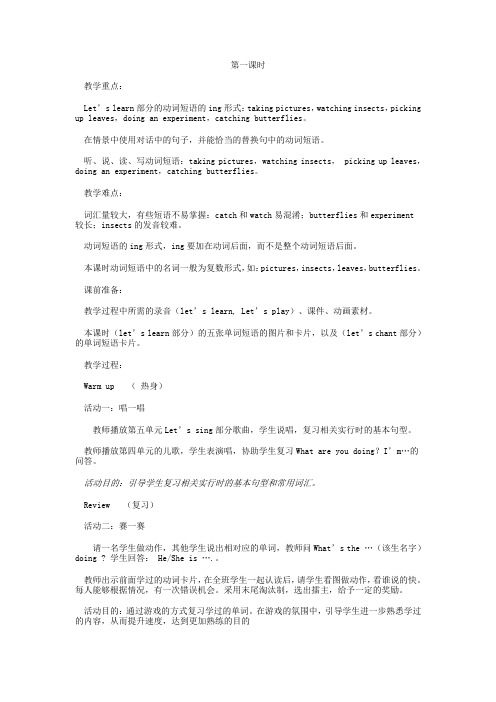
第一课时教学重点:Let’s learn部分的动词短语的ing形式:taking pictures,watching insects,picking up leaves,doing an experiment,catching butterflies。
在情景中使用对话中的句子,并能恰当的替换句中的动词短语。
听、说、读、写动词短语:taking pictures,watching insects, picking up leaves,doing an experiment,catching butterflies。
教学难点:词汇量较大,有些短语不易掌握:catch和watch易混淆;butterflies和experiment较长;insects的发音较难。
动词短语的ing形式,ing要加在动词后面,而不是整个动词短语后面。
本课时动词短语中的名词一般为复数形式,如:pictures,insects,leaves,butterflies。
课前准备:教学过程中所需的录音(let’s learn, Let’s play)、课件、动画素材。
本课时(le t’s learn部分)的五张单词短语的图片和卡片,以及(let’s chant部分)的单词短语卡片。
教学过程:Warm up (热身)活动一:唱一唱教师播放第五单元Let’s sing部分歌曲,学生说唱,复习相关实行时的基本句型。
教师播放第四单元的儿歌,学生表演唱,协助学生复习What are you doing?I’m…的问答。
活动目的:引导学生复习相关实行时的基本句型和常用词汇。
Review (复习)活动二:赛一赛请一名学生做动作,其他学生说出相对应的单词,教师问What’s the …(该生名字)doing ? 学生回答: He/She is ….。
教师出示前面学过的动词卡片,在全班学生一起认读后,请学生看图做动作,看谁说的快。
每人能够根据情况,有一次错误机会。
(整理)小学英语五年级下册《Unit 6 A Field Trip》.

教学设计:五年级下册Unit 6 A field trip B Read and write一、教学目标与要求:1、学生能够听、说、认读read and write 部分的对话,完成相应的活动。
2、3、学生能够掌握四会句子“Is he playing chess?Yes, he is .Is she counting insects ?No, she isn't ."并在情境中运用。
二、教学重点:1.通过学习,学生能够掌握四个四会句型。
2.学生能够熟练运用句型:Is she...ing .......? Yes, she is .No, she isn't .3.学生能够实现人称代词在句子中的正确运用,前后搭配正确运用。
三、教学难点:1.帮助学生在情景中选用正确的人称代词表述。
2.复习巩固本单元所学的句型和单词短语。
四、课前准备:1.教学过程中所需的录音、课件、动画素材。
2.本单元A B(Let’s learn部分)的单词短语的卡片。
3.学生准备本单元A、B中Let’s learn部分的短语卡片。
五、教学过程:(一)、Warm up (热身)1、Greetings:2 复习词组:Class, what time is it now ? It's time to have our English class .This class let's learn Unit 6 A field trip B Read and write Let's read together . do you know field trips? In this unit ,Miss White and her students are having a field trip, they are in the woods.Please look at the screen ,on the field ,what are the ss doing ?(课件出示词组和学生图像,让学生进行口头作文)(二)Presentation:1 师总结并引出下文:Yes, the ss are having a good time. But it's time to go .They are going to leave, they are leaving ,But where is John ?Where is Amy ?what are they doing now ?they can't find them .Can you guess?Tell us .please.(让学生预测文本,运用句型:Is John ....ing? Is Amy ing...?)(师配合说:maybe)2(第一遍读,默读)It's time to read ,let's find out the answers from your books.please open your books ,turn to page 75, read silently, try to answer the questions.First unline the answer, number 1 and 2, then ,write down the answers.对答案,并板书句型。
《AFieldTrip》教案范文模板

一、教学目标:1. 知识目标:(1)学生能够掌握并运用单词:field, trip, exciting, fun, learn, see, teacher, student等。
(2)学生能够理解并运用句型:What did you do? I went on a field trip. We saw many interesting things.等。
2. 能力目标:(1)学生能够听懂并参与对话,提高听力技能。
(2)学生能够运用所学知识进行情景交际,提高口语表达能力。
3. 情感目标:培养学生对户外活动的兴趣,增进同学间的友谊。
二、教学重难点:1. 单词:field, trip, exciting, fun, learn, see, teacher, student等。
2. 句型:What did you do? I went on a field trip. We saw many interesting things.等。
三、教学方法:1. 情境教学法:通过设置真实情境,让学生在实际环境中运用所学知识。
2. 交际教学法:通过小组讨论、角色扮演等活动,培养学生的人际交往能力。
3. 游戏教学法:通过趣味游戏,激发学生的学习兴趣,提高课堂氛围。
四、教学步骤:1. 热身活动(5分钟):引导学生回顾已学过的关于日常活动的词汇,如:play, swim, read等。
2. 新课导入(10分钟):(1)介绍新单词:field, trip, exciting, fun, learn, see, teacher, student等。
(2)讲解句型:What did you do? I went on a field trip. We saw many interesting things.等。
3. 对话练习(10分钟):(1)学生两人一组,模拟角色扮演,练习对话。
(2)教师巡回指导,纠正发音并给予鼓励。
4. 小组活动(10分钟):(1)学生分成若干小组,每组选择一个场景,如:公园、博物馆等。
Uni fieldtri ALetslearn教学设计及练习题修订稿

butterflies 可以分为 butter 和 fly,fly 的复数形式为 flies 等等。
教师出示以上单词图片,学生以四人小组为单位抢拼单词,拼读时小组成
员可以提供帮助。
教学 环节
师生活动
P 课外活动设计①:写一写
r o d
课外活动设计②:调查表 调查家庭成员正在做什么,然后用英语介绍.
)
skate →(
)
model3:swim → swimming
run →(
)
shop →(
)
swim →(
)
put →(
)
六. Write课(将下下作列业单词换一个字母,加
一个字母,减一个字母,变成另一个单
词)
题目
答题区
take
catch
run
up
an
too
on
sun
see
七.Do a survey.(调查表) 调查家庭成员他们正在做什么,然后用英 语介绍
小组展示,同学之间给予适当评价。
●活动设计③::Words-spelling
教师出示单词短语卡片:taking pictures,watching insects, picking
up leaves, doing an experiment,catching butterflies 学生拼读。
教师适当讲一些速记方法,如:catch 和 watch 两个词可以对比记忆;
教学 环节
师生活动
P “风采明星”
r 2. Brainstorming(头脑风暴)
e
主动词
p
doing
a
r
making
a
五年级PEP第六单元A Field Trip
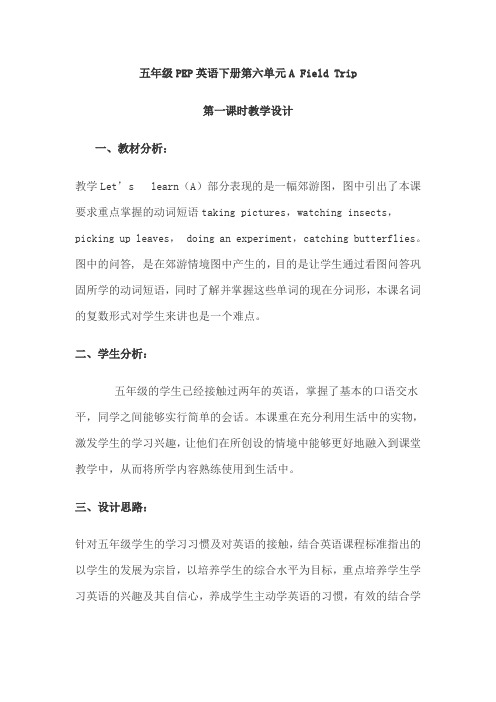
五年级PEP英语下册第六单元A Field Trip第一课时教学设计一、教材分析:教学Let’s learn(A)部分表现的是一幅郊游图,图中引出了本课要求重点掌握的动词短语taking pictures,watching insects,picking up leaves, doing an experiment,catching butterflies。
图中的问答, 是在郊游情境图中产生的,目的是让学生通过看图问答巩固所学的动词短语,同时了解并掌握这些单词的现在分词形,本课名词的复数形式对学生来讲也是一个难点。
二、学生分析:五年级的学生已经接触过两年的英语,掌握了基本的口语交水平,同学之间能够实行简单的会话。
本课重在充分利用生活中的实物,激发学生的学习兴趣,让他们在所创设的情境中能够更好地融入到课堂教学中,从而将所学内容熟练使用到生活中。
三、设计思路:针对五年级学生的学习习惯及对英语的接触,结合英语课程标准指出的以学生的发展为宗旨,以培养学生的综合水平为目标,重点培养学生学习英语的兴趣及其自信心,养成学生主动学英语的习惯,有效的结合学生学习英语的水平,我采用听、说、读、唱融于一体的教学手段,将单词、句型灵活使用,达到教学目的。
四、三维目标:1、能够听、说、读、写本课动词短语:taking pictures,watching insects, picking up leaves, doing an experiment,catching butterflies.2、能够听、说、认读“What’s Sarah doing? She’s doing an experiment.”并能在情景中使用。
3、培养学生的合作意识。
4、能说唱歌谣,并理解其含义。
5、结合本课内容,引导学生学会热爱大自然,爱护大自然,树立准确的环保意识。
五、教学重点:1、Let’s learn部分的动词短语的ing形式:taking pictures,watching insects,picking up leaves,doing an experiment,catching butterflies。
unit a field trip a read and write教学设计及练习题
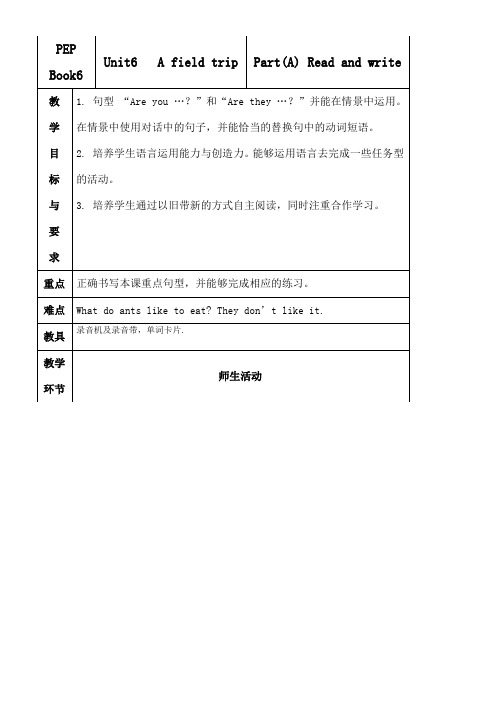
John: No, they aren’t.
Kid:Are they catching butterflies?
John: Yes, they are.
Kid: How many people can you see?
John: Five.
板
书
设
计
Unit6Afield tripPart(A)Read and write
①、they eating are honey the (.)
②、they eating are honey the (?)
③、aren’twe eating honey the (.)
Are you eating lunch?
③、aren’s we eating honey the (.)
4.Listen to the tape听音
①看录像,听出主句型。
②模仿。
5.Read aloud朗读
①个人自由朗读
②小组合作朗读
③全体学生齐读
教学环节
师生活动
P
o
s
t
-
r
e
d
i
n
g
阅
读
后
活
动
1.表演
2.Report(做报告)
Mike: Just try.
Grandma: What are they doing? Are they climbing trees?
Mike: ______________. Here’s another one.
Grandma: What are they doing? Are they reading a book?
小学英语PEP人教版五年级下册《A field trip read and write》word版教案
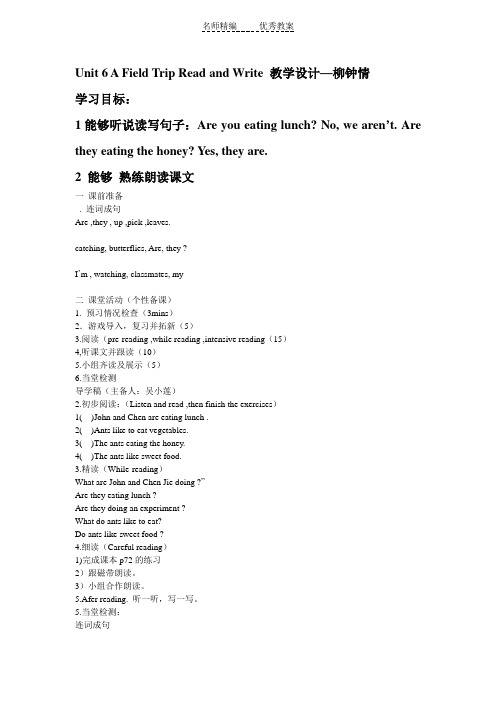
Unit 6 A Field Trip Read and Write 教学设计—柳钟情学习目标:1能够听说读写句子:Are you eating lunch? No, we aren’t. Are they eating the honey? Yes, they are.2 能够熟练朗读课文一课前准备. 连词成句Are ,they , up ,pick ,leaves.________________________catching, butterflies, Are, they ?_____________________________I’m , watching, classmates, my____________________________二课堂活动(个性备课)1. 预习情况检查(3mins)2.游戏导入,复习并拓新(5)3.阅读(pre-reading ,while reading ,intensive reading(15)4,听课文并跟读(10)5.小组齐读及展示(5)6.当堂检测导学稿(主备人:吴小莲)2.初步阅读:(Listen and read ,then finish the exercises)1( )John and Chen are eating lunch .2( )Ants like to eat vegetables.3( )The ants eating the honey.4( )The ants like sweet food.3.精读(While-reading)What are John and Chen Jie doing ?”_______________________________Are they eating lunch ?___________________________________________Are they doing an experiment ?_______________________________________What do ants like to eat?______________________________________________Do ants like sweet food ?_______________________________________________4.细读(Careful reading)1)完成课本p72的练习2)跟磁带朗读。
UnitA.field trip B Read and write教学设计及练习题

aloud:(read in groups)
Now boys andgirls, yourtime is coming!Iwill give you two minutes topracticeit!AndIhope you can believe it and do it! OK! GO!
【设计意图】语言的学习在于学生自主将其输出.
教学环节
师生活动
P
o
s
t
-
r
e
d
i
n
g
阅
读
后
活
动
play(3 minutes)
Several student showing their practical results and role play fluently.
2.Guess:What are the students doing?
3.培养学生通过以旧带新的方式自主阅读,同时注重合作学习。
重点
What are they doing?They are...... Can the animals really do something?
难点
复习巩固本单元所学的句型和单词短语。
教具
录音机及录音带,单词卡片.
教学环节
师生活动
P
r
e
p
a
三、Listen and number.(听音标号)
四、Listen and write down what they are doing.(听一听,写下他们正在做什么)
人教PEP英语五下Unit6AFieldTrip教案3
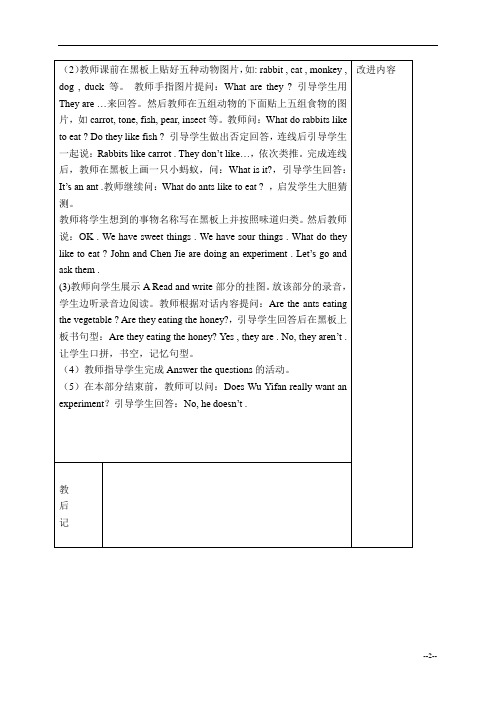
Unit6 Afield trip第三课时
课 题
Unit6 AField Trip
课型
New lesson
改进内容
教
学
目
的
1.能够四会掌握句子:Are you eating lunch? No, we aren’t . Are they eating the honey ? Yes , they are。
(3)教师向学生展示A Read and write部分的挂图。放该部分的录音,学生边听录音边阅读。教师根据对话内容提问:Are the ants eating the vegetable ? Are they eating the honey?,引导学生回答后在黑板上板书句型:Are they eating the honey? Yes , they are . No, they aren’t .让学生口拼,书空,记忆句型。
教师将学生想到的事物名称写在黑板上并按照味道归类。然后教师说:OK . We have sweet things . We have sour things . What do they like to eat ? John and Chen Jie are doing an experiment . Let’s go and ask them .
2.预习
进行“小组拼词”接力赛:学生分成若干组。教师说一个短语,然后各组学生按顺序每人说一个字母拼出该短语,拼得又快又正确的小组可以得一分。
3.新课呈现
Read and write
(1)请两名学生上台,两人一起表演一个动作。教师问:Are you catching butterflies?
(2)教师课前在黑板上贴好五种动物图片,如: rabbit , cat , monkey , dog , duck等。教师手指图片提问:What are they ?引导学生用They are …来回答。然后教师在五组动物的下面贴上五组食物的图片,如carrot, tone, fish, pear, insect等。教师问:What do rabbits like to eat ? Do they like fish ?引导学生做出否定回答,连线后引导学生一起说:Rabbits like carrot . They don’t like…,依次类推。完成连线后,教师在黑板上画一只小蚂蚁,问:What is it?,引导学生回答:It’s an ant .教师继续问:What do ants like to eat ?,启发学生大胆猜测。
UnifieldtripBReadandwrite教学设计及练习题
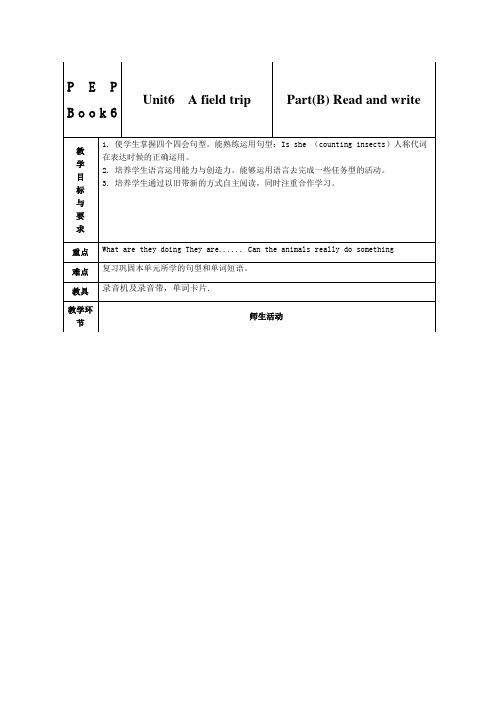
i
o
n
准
备
活
动
T: Boys and girls. You can call me “Miss Bian”.
Hello! Boys and girls.
Nice to meet you. How are you
(Look at the watch.看时间)
2. Divide the class into four groups.
运用猜的形式,既检测学生对所学语言的掌握情况,又对阅读内容做了预测,自然的导入阅读环节。
教学环节
师生活动
I
n
-
r
e
a
d
i
n
g
阅
读
中
活
动
1. general reading:
. Read the dialogue silently, and then judge the sentences.
①:John is catching butterflies.( )
T: Boys and girls, these are for you. Here you are. One by one, please.
T: This flower is for you. If you do a good job, you can get a piece. Come on! OK(激励学生)
T:Hi! Woods. We’re coming.(走向森林场景)
4. T: Boys and girls. What do you like Please do.
(四个学生选择物品,做动作。) (师转向其他学生设问,引导学生回答。)
T:What is his/her name Tell me, please.(反复渗透该句.)
- 1、下载文档前请自行甄别文档内容的完整性,平台不提供额外的编辑、内容补充、找答案等附加服务。
- 2、"仅部分预览"的文档,不可在线预览部分如存在完整性等问题,可反馈申请退款(可完整预览的文档不适用该条件!)。
- 3、如文档侵犯您的权益,请联系客服反馈,我们会尽快为您处理(人工客服工作时间:9:00-18:30)。
What are you doing?
What are you doing in the park?
I’m picking up leaves.
I’m catching butterflies.
I’m doing an experiment in the park.
Kid: Are they picking up leaves?
John: No, they aren’t.
Kid:Are they catching butterflies?
John: Yes, they are.
Kid: How many people can you see?
John: Five.
【设计意图】这个练习重点在于解决本课的教学难点:What do ants like to eat? They don’t like it并且学习了本课的新单词honey和ant。在游戏中要求学生充分练习…like…. They don’t like…,增强学生的表达能力,同时为read and write部分的学习做铺垫。
Kid: I can’t find my classmates.
John: Don’t worry. Let me help you.
Kid: Do you see my classmates?
John: Yes. I see some students.
Kid: Where are they?
John: They’re in the woods.
PEP Book6
Unit6Afield trip
Part(A)Read and write
教
学
目
标
与要Leabharlann 求1.句型“Are you …?”和“Are they …?”并能在情景中运用。在情景中使用对话中的句子,并能恰当的替换句中的动词短语。
2.培养学生语言运用能力与创造力。能够运用语言去完成一些任务型的活动。
A: Is he/she ?
B:Yes/No.
【设计意图】通过这一些简单问句和一系列动作一方面复习了What is he/she doing?另一方面增进学生的感性认识。学习相关的内容可以锻炼学生合理地组织语言及运用语言的能力。
教学环节
师生活动
P
r
e
-
r
e
a
d
i
n
g
阅
读
前
活
动
1.Do a survey.
教学环节
师生活动
I
n
-
r
e
a
d
i
n
g
阅
读
中
活
动
1.General reading略读
简单做一做:
①:There are 3 students in the park.
They are Wu, ( ) and ( ).
②:What do they look at? They look at ( )
They are (_________________).
④Are the ants eating the honey?
(______________________).
3.Read and write读写
①、they eating are honey the (.)
②、they eating are honey the (?)
根据指针指示的动物和食物引导学生用以有的知识经验判断这种动物是否喜欢这种食物,并用英语表达:…like…. They don’t like…./…like….
教师出示ant的图片,问:What is it?引导学生回答:It is an ant.
教师继续问:What do ants like to eat?启发学生大胆猜测。注意,如果学生没有说出honey,教师要把honey一词加进食物名称里。
A: ants B: ducks
③:The food in the material(文章)is ( ).
A: sweet B: sour
④:Who wants to do an experiment on himself( )
A: Wu B: Chen
⑤:The ants like( )
A: the vegetable B: the honey
【设计意图】在问答中引出一些学生所喜爱的小动物,以及小动物们所喜爱的食物。在进行口语交际的同时为下面的环节做准备。
学生边说,教师边在相应的图片下面打勾。
2.Let’s play
rabbit?? cat?? monkey?? dog?? duck教师出示两个半径不同的圆,圆心重合在一起,大圆上是一圈小动物,如:rabbit?? cat?? monkey?? dog?? duck等。(用复数形式),小圆上是一圈食物,如:carrot?? bone?? fish?? pear?? insect等,圆心有一个指针,指向右边。
Are you eating lunch?
Are you eating lunch? No, we aren’t.
Are they eating the honey? Yes, they are.
Are they eating the honey? Yes, they are.
教
学
反
思
UnitSixARead and write
Mike: ______________________.Oh, Grandma. Look! What am I doing?
Grandma: You’re holding my glasses.
Mike: Ha ha.
五、Arrange the words.(连词成句)
1.watching is insects he(?)
Mike: Just try.
Grandma: What are they doing? Are they climbing trees?
Mike: ______________. Here’s another one.
Grandma: What are they doing? Are they reading a book?
③、aren’s we eating honey the (.)
4.Listen to the tape听音
①看录像,听出主句型。
②模仿。
5.Read aloud朗读
①个人自由朗读
②小组合作朗读
③全体学生齐读
教学环节
师生活动
P
o
s
t
-
r
e
d
i
n
g
阅
读
后
活
动
1.表演
2.Report(做报告)
2.Detailed reading细读
细读文章,做出正确答案:
①What do ants like to eat?
They like to eat ( ) food.
②Are Chen and John eating lunch?
(________________________)
③What are Chen and John doing?
教师把一些食物的图片(包括动物喜欢吃的食品)贴在黑板上,提问:
What do you like to eat?
What fruits do you like?
What animals do you like?
What do dogs like?
What vegetable do you like?
What is your favourite food?…
教师将学生想到的食物名称写在黑板上并按照味道归类,然后教师说:Ok. We have sweet things. We have sour things. What do they like to eat? John and Chen Jie are doing an experiment. Let’s go and ask them.
【设计意图】音乐节奏感强,学生乐于接受,并能训练学生的乐感及听说技能。感觉与欣赏并存;放松与紧张并重。让学生在唱歌的同时对歌曲的内容有大概的了解,对歌曲中的单词有所认识,为下面知识的学习做好铺垫。
2.Free talk.(口语练习)
A: What is he/she doing?
B:He/She is……
3. Are they catching butterflies?
Kid: Let’s go and see.
John: OK.
Kid: Yes, these are my classmates. Thank you.
John: You’re welcome. Bye.
1. Where are the boy’s classmates?
2. Are they picking up leaves?
教师拨动转盘,两个圆以不同的速度转动。转动停止,此时指针所指应有一个动物,一个食物,教师问:What do rabbits like to eat?Do they like fish?
引导学生能够做出否定回答。然后引导学生说:Rabbits like carrot. They don’t like fish.
板
书
设
计
Unit6Afield tripPart(A)Read and write
①、they eating are honey the (.)
②、they eating are honey the (?)
③、aren’twe eating honey the (.)
